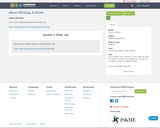
This is one of several resources for ENGL 124. https://openoregon.pressbooks.pub/aboutwriting/
- Subject:
- English Language Arts
- Material Type:
- Textbook
- Author:
- Barbara Illowsky
- Date Added:
- 02/19/2020

This is one of several resources for ENGL 124. https://openoregon.pressbooks.pub/aboutwriting/
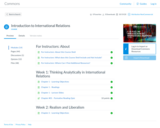
Canvas Course Shell for C-ID POLS 140 Introduction to International Relations: an introduction to international relations theory with an examination of national, international, transnational, and sub-national actors and their institutions, interactions and processes as they relate to global issues.
The content contained within this Open Education Resource (OER) was curated and/or created by Dr. Charlotte Lee at Berkeley City College, Dr. Katherine Michel at Ohlone College, and Dr. Josh Franco at Cuyamaca College. The curation and creation of this content was funded by the Academic Senate for California Community College's Open Educational Resources Initiative.
Question Banks were created by Josh Franco, Ph.D., Elizabeth Nash, M.A., and Jereme Umali, M.A..
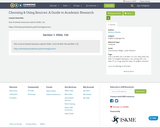
One of several resources used for ENGL 124.https://ohiostate.pressbooks.pub/choosingsources/
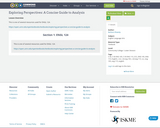
This is one of several resources used for ENGL 124. https://open.umn.edu/opentextbooks/textbooks/exploring-perspectives-a-concise-guide-to-analysis
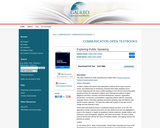
Instructors: The Third Edition includes a set of test banks which are not available to the public. For access to these resources, please contact Dr. Barbara Tucker at btucker@daltonstate.edu.
Exploring Public Speaking: The Free College Public Speaking Textbook began as the brainchild of Dr. Kris Barton, Chair of the Department of Communication at Dalton State College. It also was made possible through a generous Textbook Transformation Grant in 2015 from Affordable Learning Georgia, a highly successful program of the University System of Georgia. Dr. Barton asked me to help him author/compile the text.
The goal was to provide a high-quality, usable, accessible, and low-cost textbook for the hundreds of students who take COMM 1110 at Dalton State College every year. This course is required of all degree-seeking students. We have been able to save students hundreds of thousands of dollars already with this text. Unexpectedly and happily, the text has also been downloaded close to 14,000 times (as of August 2018) all over the world and has been adopted at many other institutions.
Dr. Barton and I worked on creating the textbook from July 2015 until May 2016, with the goal of going live with the text in Summer of 2016. Tragically Dr. Barton passed away in early May, a reality that still does not seem real. He has been greatly missed as a friend, colleague, father, scholar, teacher, and mentor.
The launch of the book proceeded; however, due to the loss of Dr. Barton, the ancillaries were not finished. In Summer 2017 I took on a significant revision and updating which I named the Second Edition. I included in that edition information on college student success in the appendices. In January 2018, a colleague, Matthew LeHew, and I won a grant from the University System to create the ancillaries and improve the format for more accessibility. I decided to remove the “Dalton State” from the title and most examples for wider appeal. An appendix on library research retains the information for specific use of Roberts Library on our campus.
Over 90% of the book is original with Dr. Barton, me, or other colleagues at Dalton State College. Some parts, specifically from Chapters 9, 10, and 15, are adapted from another open resource public speaking text whose author prefers not to be cited.
This Third Edition, along with including necessary updates and being formatted with different software, includes four more appendices: one on online speaking, one on APA, one on humor and storytelling in public speaking, and one on Dalton State’s Library. I have also tried to clarify concepts, to provide “case studies” to show the rhetorical process, and include more outlines and examples.
We think this book is especially useful in coverage of PowerPoint, audience responsiveness, ethics in public speaking, special occasion speeches, and structure of speeches. Three ancillaries are available: electronic “flash cards” for study, Powerpoints on the 15 main chapters, and test banks for the 15 main chapters.
Thank you for downloading Exploring Public Speaking, and the co-authors and I truly wish you happy teaching and learning with it. We welcome input. If you choose to use it, let us know at btucker@daltonstate.edu.
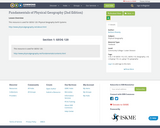
This resource is used for GEOG 120: Physical Geography Earth Systems http://www.physicalgeography.net/about.html
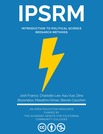
Introduction to Political Science Research Methods, 1st edition, is an Open Education Resource Textbook that surveys the research methods employed in political science. The textbook includes chapters that cover: history and development of the empirical study of politics; the scientific method; theories, hypotheses, variables, and units; conceptualization, operationalization and measurement of political concepts; elements of research design including the logic of sampling; qualitative and quantitative research methods and means of analysis; and research ethics.
Authors:
- Josh Franco, Cuyamaca College
- Charlotte Lee, Berkeley City College
- Kau Vue, Fresno City College
- Dino Bozonelos, Victor Valley College
- Masa Omae, San Diego City College
- Steven Cauchon, Imperial Valley College
PDF Version ISBN: 978-1-7351980-0-2
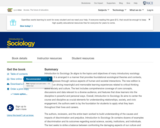
Introduction to Sociology is intended for a one-semester introductory sociology course. Conceived of and developed by active sociology instructors, this up-to-date title and can be downloaded now by clicking on the "Get this book" button below. This online, fully editable and customizable title includes sociology theory and research; real-world applications; simplify and debate features; and learning objectives for each chapter
Note: this resource now links to the third edition, released in 2021. Its record is in OER Commons to allow users to see endorsements, reviews, etc...
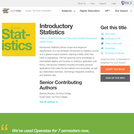
Introductory Statistics follows scope and sequence requirements of a one-semester introduction to statistics course and is geared toward students majoring in fields other than math or engineering. The text assumes some knowledge of intermediate algebra and focuses on statistics application over theory. Introductory Statistics includes innovative practical applications that make the text relevant and accessible, as well as collaborative exercises, technology integration problems, and statistics labs.
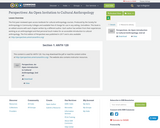
The first peer-reviewed open access textbook for cultural anthropology courses. Produced by the Society for Anthropology in Community Colleges and available free of charge for use in any setting. 2nd edition. This book is an edited volume with each chapter written by a different author. Each author has written from their experiences working as an anthropologist and that personal touch makes for an accessible introduction to cultural anthropology. The first edition of Perspectives was published in 2017 and is also available at: http://perspectives.americananthro.org/
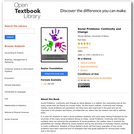
Social Problems: Continuity and Change by Steve Barkan is a realistic but motivating look at the many issues that are facing our society today. As this book’s subtitle, Continuity and Change, implies, social problems are persistent, but they have also improved in the past and can be improved in the present and future, provided that our nation has the wisdom and will to address them.
It is easy for students to read a social problems textbook and come away feeling frustrated by the enormity of the many social problems facing us today. Social Problems: Continuity and Change certainly does not minimize the persistence of social problems, but neither does it overlook the possibilities for change offered by social research and by the activities of everyday citizens working to make a difference. Readers of Steve Barkan’s book will find many examples of how social problems have been improved and of strategies that hold great potential for solving them today and in the future.
You will find several pedagogical features help to convey the “continuity and change” theme of this text and the service sociology vision in which it is grounded: Each chapter begins with a “Social Problems in the News” story related to the social problem discussed in that chapter. These stories provide an interesting starting point for the chapter’s discussion and show its relevance for real-life issues. Three types of boxes in each chapter provide examples of how social problems have been changed and can be changed.